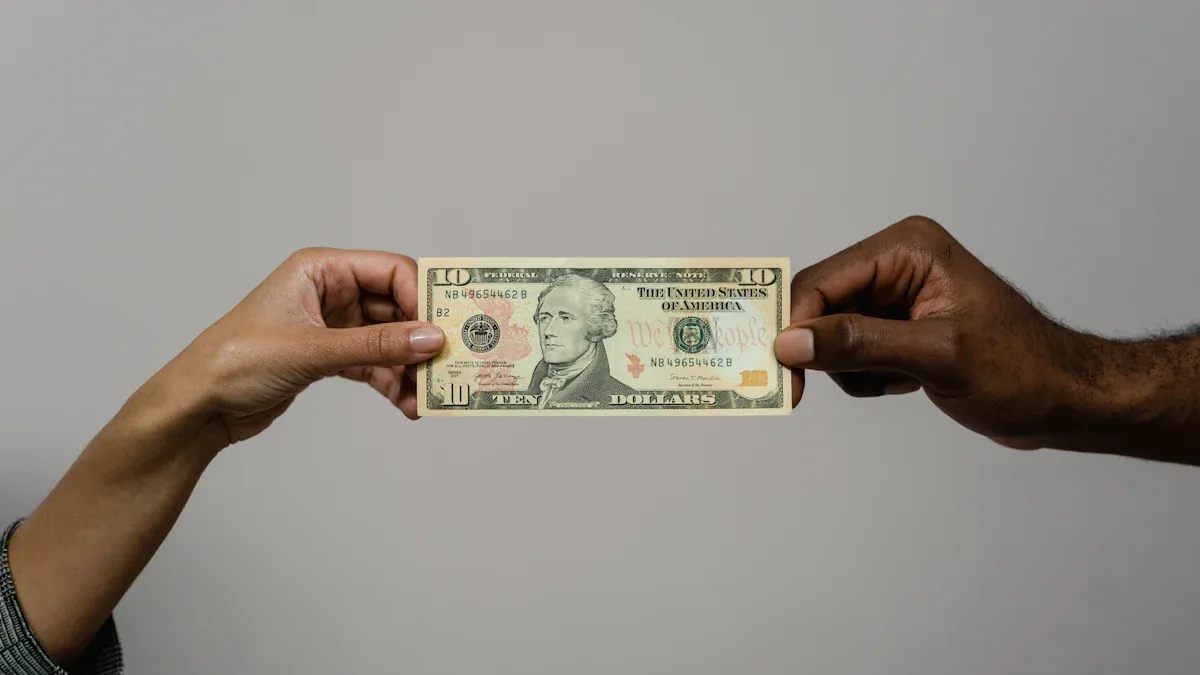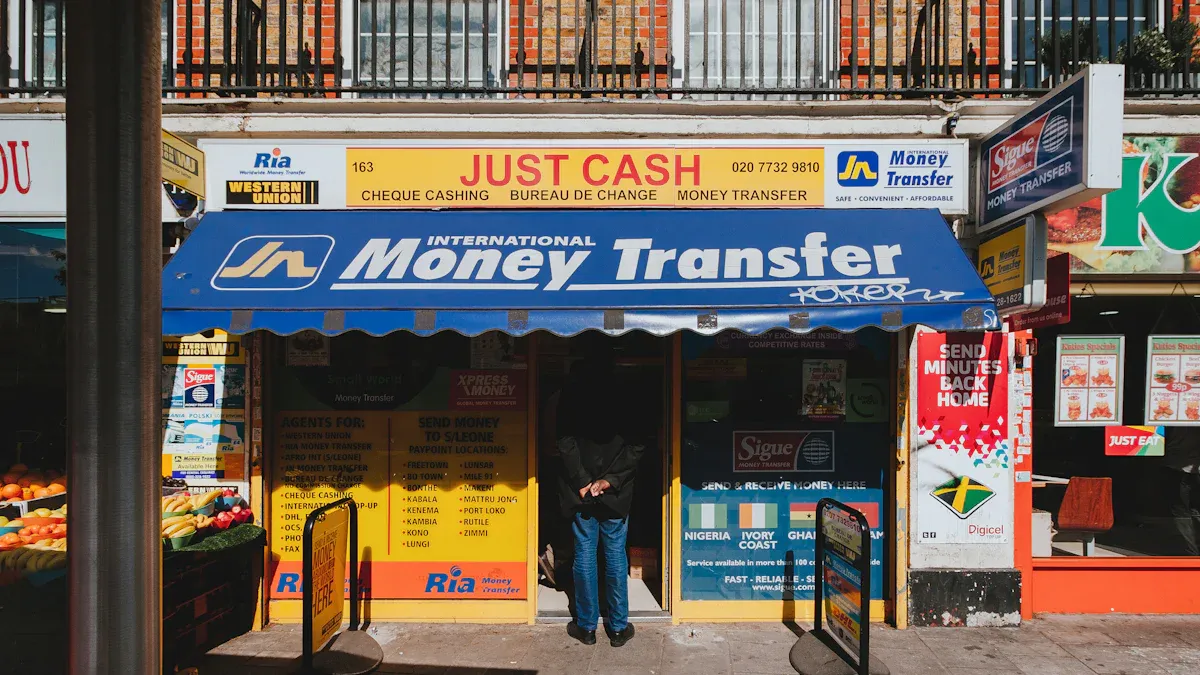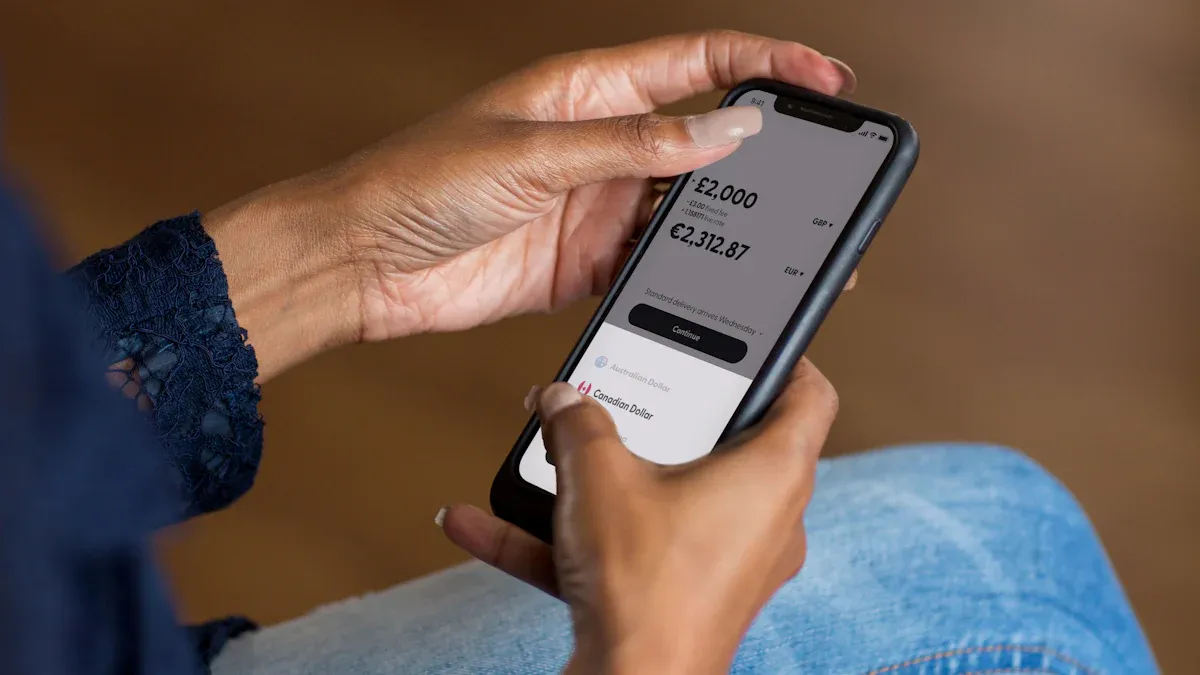- EasyCard
- Trade
- Help
- Announcement
- Academy
- SWIFT Code
- Iban Number
- Referral
- Customer Service
- Blog
- Creator
Sending Remittances from the US to a GCash Account

Image Source: pexels
The total amount you remit from the US to the Philippines continues to grow each year, reaching $2.221 billion from January to July 2025. The table below shows several common fund transfer methods, their fees, exchange rates, and delivery speeds to help you quickly understand your options:
| Transfer Method | Fees | Exchange Rate | Delivery Speed |
|---|---|---|---|
| Online Providers | Low transfer fees starting from 0.41% | Mid-market exchange rate | Payments can arrive quickly or instantly |
| Xoom | Variable fees based on payment method | Exchange rate includes markup | Payments may arrive within minutes |
| Sendwave | No fees for transfers to the Philippines | Exchange rate includes markup | Arrives in GCash within minutes |
| Bank | Fees may be higher | Exchange rate includes markup | Arrival time varies by bank |
You can choose the most suitable method to transfer funds to a GCash account based on your needs.
Key Points
- Choosing the right transfer method can save on fees and improve delivery speed. Compare fees and exchange rates of different services to find the best option for you.
- Using third-party remittance services like Western Union and Remitly can often achieve fast delivery, suitable for urgent transfer needs.
- Ensure the recipient’s information matches the GCash account to avoid transfer failures or delays.
- For large transfers, prepare identity verification documents in advance to ensure smooth processing and avoid delays.
- Monitor exchange rate fluctuations and choose the right timing for transfers to maximize the received amount and minimize losses.
Fund Transfer Methods

Image Source: unsplash
Third-Party Remittance Services
You can choose from various third-party remittance services to transfer funds to a GCash account. These services include Western Union, WorldRemit, Remitly, and others. They support online, mobile app, or offline agent operations, catering to different user needs. The table below shows mainstream services and their features:
| Service Name | Description |
|---|---|
| Western Union | Allows you to send funds to a GCash account online, via the app, or through agent locations; the recipient must have a fully registered profile. |
| WorldRemit | You can send funds to a GCash account online through the WorldRemit app, offering convenient operation. |
These services have their own advantages and disadvantages. You can refer to the table below to make a choice:
| Service Provider | Advantages | Disadvantages |
|---|---|---|
| Remitly | Covers over 170 countries, digitally convenient, suitable for tech-savvy regions | Cash pickup network less extensive than Western Union |
| Western Union | Over 500,000 cash pickup points, ideal for emergencies | Higher fees, less competitive exchange rates compared to Remitly |
- Remitly supports fast cash transfers with favorable exchange rates, suitable for bank or mobile wallet transfers.
- Western Union has extensive coverage, supporting fund transfers to over 200 countries, but fees are typically higher.
If you need to complete a fund transfer quickly in an emergency, consider prioritizing Western Union or Remitly. Third-party remittance services often provide instant or same-day delivery, ideal for scenarios with high speed requirements. You can also save on transfer fees and get better exchange rates through these services. For people in remote areas or with limited banking access, online or mobile app operations are more convenient. These services use advanced security measures, including multi-factor authentication and encryption, to ensure your funds are secure.
You may face some challenges when choosing third-party remittance services. For example, exchange rate fluctuations between USD and PHP can affect the amount the recipient receives. Some services may charge hidden fees, reducing the final received amount. Identity verification steps may cause transfer delays, and network issues could impact transaction timeliness.
US Bank Account Transfers
You can also transfer funds directly to a GCash account from a US bank account. This method is suitable for users with a US bank account who prefer direct operations. GCash supports nearly anyone with an internet connection and a US bank account. You can easily transfer funds to GCash and then to the final recipient. The entire transaction process is secure and reliable, with no additional fees.
The fund transfer process is as follows:
- Select a bank account: Choose a saved bank account or select from a list of partner banks.
- Enter information: Fill in the required details and click to send funds.
- Review information: Verify the details and click confirm.
- Receive confirmation: You can view, download, or share the receipt, and the system will send a confirmation via email.
US bank account transfers are suitable for users with larger transfer amounts and high security requirements. You can enjoy low fees and a stable service experience. This method is more reliable for scenarios requiring long-term, regular fund transfers.
If you want a stable fund transfer process without additional fees, US bank account transfers are a worthwhile option. You can flexibly choose the most suitable method based on your needs.
Fund Transfer Process
Third-Party Platform Operations
You can transfer funds to a GCash account through third-party remittance services. The process is simple, ideal for users who want to complete transfers quickly. Here are the detailed steps:
- Open the GCash app homepage and click “Cash In”.
- Select “Global Banks and Partners.”
- From the list of remittance partners, choose your preferred third-party platform (e.g., Western Union, Remitly, etc.).
- Follow the platform’s instructions, filling in the recipient’s information, including the GCash registered name and phone number. Ensure the information matches exactly, or the transfer may fail.
- Review the cash-in instructions and confirm the recipient has completed GCash account registration and identity verification.
- Enter the transfer amount (in USD), verify all details, and submit.
- Wait for the platform to process; funds typically arrive within minutes. For example, Ria Money Transfer usually completes processing within minutes.
Friendly Reminder: Before initiating a transfer, confirm the recipient’s e-wallet cash-in limit to avoid transaction failures due to exceeding limits.
The identity verification step is critical. You need to provide a government-issued ID, such as a valid passport, driver’s license, or postal ID. Some platforms may require a selfie for identity verification, especially when creating or updating an account. GCash follows Know Your Customer (KYC) protocols to verify personal information, preventing fraud and money laundering.
You may encounter common issues during the process. The table below lists errors that may occur during third-party platform transfers and how to address them:
| Issue Type | Description |
|---|---|
| Unauthorized Deductions | Unauthorized deductions from the user’s account. |
| Technical Issues | Issues with BancNet’s bank transfer function, preventing successful transfers. |
| Refund Delays | GCash commits to refunding affected transaction amounts to the user’s GCash wallet within 24-48 hours. |
If you encounter transaction failures or service interruptions, contact the platform’s customer service for assistance and appeal channels.
Bank Account Operations
You can also transfer funds directly to a GCash account from a US bank account. This method is suitable for users with larger transfer amounts and high security requirements. The process is as follows:
- Log in to your US bank account and navigate to the international remittance or e-wallet transfer page.
- Enter the recipient’s information, including name, phone number, address, and reason for the transfer. Ensure all information matches the GCash registered details.
- Input the transfer amount (USD), verify the details, and submit the request.
- The bank system will perform identity verification, typically requiring you to upload a government-issued ID. Some banks may require facial recognition or SMS verification.
- Wait for the bank to process the transfer request. Arrival times vary by bank; some offer same-day delivery, while others may take 1-2 business days.
During bank operations, note the following:
- The recipient must have a registered and verified GCash account.
- Banks strictly verify identity information to prevent fraud risks during transfers.
- For large transfer amounts, banks may require additional documents, such as proof of funds or recipient relationship details.
You may encounter the following issues during the process:
| User Feedback | Bank Response |
|---|---|
| Transaction Failure | Users report recent transaction failures despite account deductions. |
| Service Interruptions | Major banks report issues with transfers to GCash accounts. |
| Unavailable Features | Some banks indicate their GCash transfer function is temporarily unavailable. |
If you encounter these issues, contact the bank’s customer service to request a refund or check transaction status. Banks typically process refund requests within 24-48 hours.
Tip: When entering recipient information, double-check the name and phone number to ensure they match the GCash registered details. Mismatched information can lead to transfer failures or delays.
When transferring funds through third-party platforms or bank accounts, pay attention to identity verification, information accuracy, and arrival times. Choosing the right method can improve transfer efficiency and ensure fund security.
Fees and Exchange Rates
Fee Explanation
When choosing a fund transfer method, fees are a critical factor to consider. Different third-party remittance services and US bank account transfers have varying fee structures. Below are common fee types:
- Fixed Fees: Some platforms, like Western Union, charge a fixed fee, typically between USD 5-15, depending on the transfer amount and delivery speed.
- Percentage-Based Fees: Platforms like Remitly charge a percentage of the transfer amount, starting as low as 0.41%.
- Hidden Fees: Some services include a markup in the exchange rate, making fees appear lower but reducing the final received amount.
You can refer to the table below to compare fee structures of different services:
| Service Platform | Fixed Fees (USD) | Percentage Fees | Exchange Rate Markup |
|---|---|---|---|
| Western Union | 5-15 | None | Yes |
| Remitly | 0-5 | From 0.41% | Yes |
| Sendwave | 0 | None | Yes |
Tip: Before transferring, carefully read the platform’s fee details to avoid reduced received amounts due to hidden fees.
Exchange Rate Impact
Exchange rate fluctuations directly affect the amount received in your GCash account. When transferring funds, changes in the USD to PHP exchange rate can have the following impacts:
- Exchange rate fluctuations directly affect the conversion rate from USD to PHP.
- The strength of the exchange rate causes variations in the PHP amount received.
- Transfer fees further impact the final received amount.
You can use GCash’s “Cash In” function to fund USD through verified partners like Western Union. This method is advantageous if you want to leverage a strong PHP or avoid losses due to currency depreciation. Some platforms also allow you to withdraw funds in USD, avoiding uncertainties from exchange rate conversions.
The main impact of exchange rate fluctuations is exchange rate risk. This risk causes uncertainty in transaction value during currency conversion. For cross-border transfers, both individuals and businesses need to monitor exchange rate changes and choose the right transfer timing.
Documents and Verification

Image Source: unsplash
Basic Documents
When remitting from the US to a GCash account, you need to prepare the necessary documents in advance to ensure a smooth transfer. You typically need the following:
- Valid US government-issued ID (e.g., passport, driver’s license)
- Social Security Number
- US local address
- Debit card or Pomelo Mastercard® for payment
- Recipient’s GCash registered phone number
- Recipient’s name (matching the GCash account)
- Recipient’s bank account details (if applicable)
- Recipient’s verification code (required by some platforms)
When receiving funds in the Philippines, the recipient also needs to provide valid identification. Common IDs include:
- National ID (card or paper type)
- Digital National ID
- Passport
- HDMF (Pag-Ibig Loyalty Plus)
- Driver’s License
- Philippine Postal ID
- PRC ID
- UMID
- SSS ID
Friendly Reminder: When entering recipient information, ensure the name, phone number, etc., match the GCash account exactly. Mismatched information can lead to transfer failures or delays.
Large Transfer Requirements
If you need to transfer large amounts, you must pay attention to GCash and partner platform limits. Different platforms have specific restrictions on single, daily, and monthly transfer amounts. Refer to the table below:
| Limit Type | Amount (USD Equivalent) |
|---|---|
| Maximum Per Transaction | Approximately 50,000 PHP per recipient daily (first-time transfers capped at ~30,000 PHP) |
| Monthly Recipient Limit | Approximately 100,000 PHP per recipient |
| Recipient Wallet Limit | 100,000–500,000 PHP per GCash account (depending on account status) |
For large transfers, platforms typically require additional identity verification documents. For example, banks may request proof of funds, recipient relationship details, or even video verification. Prepare these documents in advance to avoid delays due to incomplete materials.
It’s recommended to consult the remittance platform or bank customer service before large transfers to confirm required documents and processes. This saves time and ensures funds arrive safely and on time.
Issues and Solutions
Common Failure Reasons
When transferring from the US to a GCash account, you may encounter issues like funds not arriving or transaction failures. Understanding common reasons helps you mitigate risks. Below are the most common failure reasons:
- Insufficient account balance. Ensure your account has sufficient funds before initiating a transfer.
- Network issues or server failures. Unstable networks or platform maintenance can cause delays or failures.
- System delays. During peak times, GCash processing may slow, extending arrival times by a few minutes.
- Incorrect information entry. Mismatched recipient name or GCash phone number can lead to transaction failures.
- Sender bank issues. US bank systems may occasionally experience delays or technical issues, affecting transfers.
When operating, carefully verify all information to avoid errors that prevent funds from arriving. During system maintenance or peak times, try transferring later.
Friendly Reminder: When entering the GCash number and recipient name, ensure they match the registered information. Incorrect information is a leading cause of transaction failures.
Customer Service and Appeals
If you find funds haven’t arrived or a transaction has failed, you can appeal through the GCash platform. Follow these steps:
- Log in to the GCash app.
- Click “Transactions” and locate the relevant transaction record.
- Select “Get Help.”
- Click “I didn’t receive the money” and submit an appeal request.
After submitting an appeal, GCash customer service will address your issue within 24-48 hours. You can track the appeal progress to ensure fund safety. If you encounter bank system failures or third-party platform delays, contact the respective platform’s customer service for further assistance.
It’s recommended to prepare transaction screenshots and relevant documents when appealing to speed up processing. You can get help through GCash’s official channels for any questions.
Security and Tracking
Fund Security
When transferring from the US to a GCash account, fund security is a top consideration. GCash and mainstream remittance services employ multiple security measures to ensure your funds and personal information are not accessed without authorization. GCash uses advanced encryption technology to protect your transaction data and account information. Mynt’s CFO has stated: “We use advanced encryption technology to ensure users’ sensitive information is not accessed without authorization, making GCash a secure transfer platform.” When logging in and operating, the system requires multi-factor authentication, including passwords, one-time passwords (OTP), and biometric verification (e.g., fingerprint or facial recognition). These measures effectively prevent account theft. The platform also monitors transactions in real time, freezing accounts promptly upon detecting suspicious activity to protect your funds. GCash is regulated by the Bangko Sentral ng Pilipinas (BSP), and all financial transactions comply with international standards. You can confidently use GCash for cross-border transfers.
| Security Measure | Description |
|---|---|
| Multi-Factor Authentication | Passwords, OTP, and biometric verification ensure account security |
| Advanced Encryption Technology | Protects sensitive data during transmission and storage |
| Real-Time Transaction Monitoring | Identifies and responds to suspicious activities promptly |
| Fraud Protection Guarantee | Compensates for unauthorized transactions, boosting user confidence |
| One Device, One Account Policy | Only registered devices can access accounts, reducing hacking risks |
| AI-Driven Security Tools | Analyzes user behavior in real time to proactively detect risks |
When using GCash and remittance services, it’s recommended to regularly update passwords and enable all available security features to further enhance account security.
Real-Time Tracking
After completing a fund transfer, how can you track the fund status in real time? Mainstream remittance services and GCash provide convenient tracking tools. You can use tracking systems from platforms like ACE to monitor transaction progress at any time. After each transfer, you’ll receive SMS and email notifications, keeping you informed of the arrival status immediately. You can check the fund status in real time via the remittance service’s online account or mobile app. GCash also notifies recipients via SMS, alerting them when funds have arrived or are available for withdrawal. Simply log in to your account to confirm whether the bank transaction was successful. Below are common real-time tracking methods:
- Check transfer status via the remittance service’s online account or app.
- Receive SMS and email notifications for timely updates on arrival progress.
- Log in to the GCash account to view balance and transaction records directly.
- Use tracking systems from platforms like ACE to monitor each transaction.
During cross-border transfers, save all transaction notifications and receipts. If you notice anomalies, contact the platform’s customer service promptly to ensure fund security.
When choosing a US-to-GCash transfer method, consider the following key factors:
- Low transaction fees to maximize the received amount (priced in USD).
- Favorable exchange rates to ensure recipients receive more funds.
- Operational convenience, supporting mobile wallets and fast delivery.
You can prioritize reputable remittance services, track exchange rates, and compare customer feedback across platforms. For large transfers, prepare identity verification documents in advance to ensure funds arrive safely and on time.
FAQ
How long does it take for funds to arrive in GCash?
You can typically receive funds within minutes. Some banks or platforms may take 1-2 business days. Arrival speed depends on the service provider and transfer method.
What identity verifications are required for transfers?
You need to upload a US government-issued ID. Some platforms require facial recognition or SMS verification. Identity verification helps ensure fund security.
How are fees calculated? Are there hidden fees?
When using third-party platforms, fees may be fixed or percentage-based. Some platforms include markups in the exchange rate. Carefully review fee details to avoid hidden costs.
Are there limits on single or daily transfers?
You can transfer up to approximately 50,000 PHP (USD equivalent) per transaction daily, with a monthly limit of about 100,000 PHP. GCash accounts also have wallet limits. Consult platform customer service before large transfers.
From Western Union to Sendwave, multiple options offer convenient ways to transfer funds from the US to a GCash account. Whether prioritizing speed, cost, or ease of use, there’s a service to suit different needs. The key lies in carefully verifying recipient details, understanding each platform’s fee structure and exchange rate markups, and utilizing real-time tracking to ensure safe and efficient delivery.
When comparing options, BiyaPay presents an alternative that combines affordability with added functionality. It offers fees as low as 0.5% and supports near-instant transfers. Users can check exact costs beforehand using the real-time exchange rate calculator. Furthermore, once funds arrive, they can be directly used to invest in stocks, enabling integrated remittance and wealth growth without the need for complex overseas accounts.
For users looking to optimize cross-border money flows and seeking greater transparency and utility for their transferred funds, platforms offering such integrated services are worth considering. Learn more at BiyaPay.
*This article is provided for general information purposes and does not constitute legal, tax or other professional advice from BiyaPay or its subsidiaries and its affiliates, and it is not intended as a substitute for obtaining advice from a financial advisor or any other professional.
We make no representations, warranties or warranties, express or implied, as to the accuracy, completeness or timeliness of the contents of this publication.




Contact Us
Company and Team
BiyaPay Products
Customer Services
is a broker-dealer registered with the U.S. Securities and Exchange Commission (SEC) (No.: 802-127417), member of the Financial Industry Regulatory Authority (FINRA) (CRD: 325027), member of the Securities Investor Protection Corporation (SIPC), and regulated by FINRA and SEC.
registered with the US Financial Crimes Enforcement Network (FinCEN), as a Money Services Business (MSB), registration number: 31000218637349, and regulated by FinCEN.
registered as Financial Service Provider (FSP number: FSP1007221) in New Zealand, and is a member of the Financial Dispute Resolution Scheme, a New Zealand independent dispute resolution service provider.




















